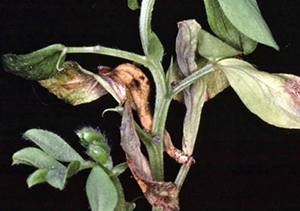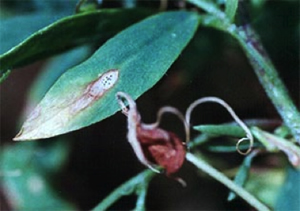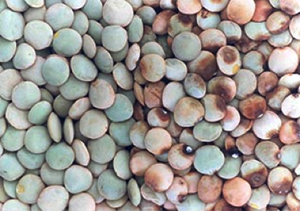Ascochyta blight of lentil
Ascochyta blight is a serious disease of Victorian lentil crops. The disease is favoured by high spring rainfall and prolonged wet periods.


Note the dark pycnidia within the centre of the lesion.
While the disease can cause leaf abscission, it may also discolour seed which can result in the downgrading of seed quality and a reduction in their market value.
What to look for
All above ground plant parts of lentil plants can be affected by ascochyta blight. Symptoms may appear on plants from the seedling to mature stages.
The disease appears as spot-like lesions which are initially light grey, but become tan with a dark brown margin.
The centres of lesions become speckled with pycnidia (tiny, dark fruiting bodies). The presence of pycnidia is the best way of identifying ascochyta blight lesions from those caused by other diseases such as botrytis grey mould or stemphylium blight. Heavy infestations of ascochyta blight will cause premature leaflet drop and stem dieback at the growing tips giving plants a blighted appearance.
Pod infection can lead to seed infection and discolouration of the seed.
Infected seed generally has brown patches on the seed surface, but may show no symptoms at all. Compared to healthy seed, heavily infected seed is purplish-brown, shrivelled and reduced in size.

Disease cycle
The fungal pathogen Ascochyta lentis that causes ascochyta blight can survive in infected seed, and in previously infected lentil stubble.
Seed can remain infected for several years. Sowing infected seed can give rise to infected seedlings, and the appearance of symptoms at the seedling stage.
Previously infected stubble is an important source of fungal inoculum. Spores are produced on old stubble and are spread to plants by rain splash. Further spread from plant to plant within crops then occurs through rain splash.
The development of ascochyta blight epidemics is largely determined by the prevailing environmental conditions, especially the presence of moisture. Infection can occur at any stage of plant growth. Wet conditions late in the season, provides ideal conditions for pod infection which can result in seed discolouration.

Economic importance
Ascochyta blight is a common disease in all areas of Victoria where lentils are grown and is favoured by cool, wet conditions.
The disease can reduce crop yields in wet seasons but mainly affects seed quality and marketability. Seed discoloured as a result of ascochyta infection if often heavily discounted in price and may be rejected by some buyers.
Management
Ascochyta blight control is essential when growing green lentils for the human consumption market.
Variety
Ascochyta blight resistant varieties are now available. Select the variety with the highest level of resistance to ascochyta blight that is suitable for your district.
For further information on the disease ratings of current varieties refer to the Victorian Pulse Disease Guide.
Seed selection
Only sow seed with less than 5 per cent ascochyta infection, and preferably use seed with nil infection. Using old or damaged seed can reduce seedling vigour and increase susceptibility to disease.
Seed treatment
Use a registered seed treatment for the control of seed-borne diseases in lentil.
Seed treatments can have a deleterious effect on rhizobia. Therefore, seed should be treated with fungicide and then inoculated with rhizobia in two separate operations. Rhizobia should be applied to seed immediately before sowing, especially on acid soils.
Paddock selection
Infected crop residues can harbour Ascochyta lentis, the causal agent of ascochyta blight. Therefore, avoid planting this season's crop near old lentil stubble.
A program of stubble reduction may also be undertaken by grazing or burying to reduce the carryover of infected stubble into the following season.
Allow a break of at least 3 years between lentil crops.
Sowing rate
Follow the recommended sowing rates for your district and remember that sowing rates may vary between varieties.
Time of sowing
Plan to sow at the optimum time for your district. Early sowing increases the likelihood of infection and development of the disease.
Foliar fungicides
In areas of high risk, it may be necessary to apply foliar fungicides to protect crops, especially if a susceptible variety is grown. Use a registered product and remember that most fungicides are protectants, and are only effective if applied before disease development.
Fungicides should be applied according to label directions for use, ensuring the key points of spray timing and frequency are observed as well as grazing and harvest withholding periods.
Harvest
Plan to harvest as early as possible to minimise ascochyta infection on seed.
Clean seed
Using old or damaged seed can reduce seedling vigour and increase susceptibility to infection. Only sow seed with less than 5 per cent ascochyta infection. Preferably use seed with nil infection.
Resistant varieties
Use varieties with greatest resistance.
There are a range of varieties available that are MR or R to ascochyta infection with attributes to suit most lentil growing areas in Victoria.
Further information
Detailed information on each of the pulse diseases can be obtained from:
- Pulse Australia
- National Variety Trials
- Lentil Southern Region – GrowNotes
- Victorian Winter Crop Summary
- Victorian Pulse Disease Guide
- Seed Health Testing in Pulse Crops
- Pulse Seed Treatments and Foliar Fungicides
Contact
Dr Joshua Fanning
Pulse Pathologist – Horsham
0419 272 075
Field Crops Pathology
Grains Innovation Park
110 Natimuk Rd
Horsham 3400
03 5450 8301
Or call the Customer Service Centre, 136 186
Acknowledgments
Trevor Bretag, Luise Sigel and Helen Richardson. Support by the Grains Research Development Corporation is gratefully acknowledged.